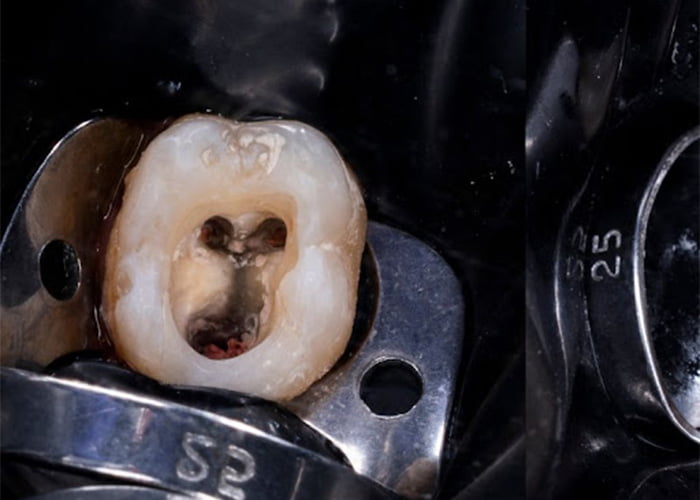Knowing what to expect is essential for a root canal. One of the most common questions patients have is, “How long does a root canal take ?” This article provides an overview of the average length of the root canal process.
Both an abscess and the need for extraction are prevented by the process. Once decay has started on a tooth, it must be addressed as soon as feasible. The decay may get worse the longer it is permitted to continue. Eventually, the harm caused by the decay could result in further dental health problems, like a root pulp infection. The elimination of damaged, dead, and/or infected root pulp is the goal of root canal treatment, also referred to as a “root canal.” One of the most common questions patients have is, “How long does a root canal take?” This article provides an overview of the root canal procedure, including the average length of time for each process step. By understanding the timeline for a root canal, you can better prepare for your treatment and feel more confident in the care you receive.
Who needs a root canal?
A root canal is a dental procedure that is used to treat a tooth that has become infected or inflamed in the pulp, which is the soft tissue inside the tooth. A root canal is typically recommended when the pulp of a tooth becomes damaged or infected, and the infection is spreading to the surrounding tissues or causing significant pain.
There are several signs and symptoms that may indicate the need for a root canal. These include:
- Severe tooth pain, particularly when chewing or biting down
- Sensitivity to hot or cold temperatures that lingers after the source of the temperature change has been removed
- Swelling or tenderness in the gums near the affected tooth
- Discoloration of the tooth
- A small bump on the gums near the affected tooth
- A persistent bad taste or odor in the mouth

What’s involved in a root canal procedure?
Root canal procedures involve drilling a hole into the tooth and removing the soft center, known as the dental pulp. After the pulp is removed, the space is filled and sealed with a rubber-like material called gutta-percha to provide stability and prevent further infection. The goal of the procedure is to save the tooth and prevent the need for extraction.

How long does it take to do a root canal?
The length of a root canal procedure can vary depending on several factors, including the location of the tooth, the complexity of the root canal, and the skill level of the dentist or endodontist performing the procedure. In general, a root canal can take anywhere from 30 minutes to 2 hours to complete.
Molars
Root canals on molars, which are large back teeth with multiple roots, can be more complex and take longer to complete than root canals on other teeth. On average, a root canal on a molar can take 1.5 to 2 hours to complete.
Premolars
Premolars are the teeth located between the molars and the canines. Root canals on premolars are typically less complex and take less time to complete than those on molars. On average, a root canal on a premolar can take 45 minutes to 1 hour to complete.
Canine and incisors
Canine and incisor teeth are located at the front of the mouth and have a single root. Root canals on these teeth are typically the least complex and take the shortest time to complete. On average, a root canal on a canine or incisor can take 30 to 45 minutes to complete.
See more: Is it cheaper to get a root canal or extraction?

Why do root canals sometimes require two visits?
The decision to perform a root canal in one or two visits depends on the complexity of the procedure and the individual patient’s needs. If the tooth is severely infected, it may be necessary to allow the infection to heal before proceeding with the procedure.
If the root canal is particularly complex, the dentist or endodontist may decide to break up the procedure into multiple appointments to ensure it is done correctly. Time constraints may also play a role in the decision, as patients with busy schedules may not have the time to sit through a lengthy procedure. Ultimately, it is important to follow the recommended treatment plan to ensure the best possible outcome.
Read more: What is a partial dentures?

Oral care following a root canal
After a root canal procedure, it is important to take good care of the treated tooth to ensure proper healing and prevent further problems. Here are some tips for oral care following a root canal:
- Take prescribed medication: The dentist may prescribe medication to manage pain and prevent infection, take it as prescribed.
- Avoid chewing on the treated tooth: It is important to avoid chewing on treated teeth until the crown or permanent filling is in place.
- Practice good oral hygiene: Brush and floss regularly to maintain good oral hygiene. Be gentle around the treated tooth to avoid irritating the area.
- Follow a soft diet: For the first few days after the procedure, it is recommended to eat soft foods to avoid putting pressure on the treated tooth.
- Attend follow-up appointments: Attend follow-up appointments to ensure proper healing and address any concerns.
- Wear a mouthguard: The dentist recommends wearing a mouthguard at night to protect treated teeth and prevent further damage.
By following these tips, you can help ensure that your root canal procedure is successful and that your tooth remains healthy for years to come.
Root Canal Treatment at Dental Dentist For Life
At our dental practice in Marysville, Ohio, we provide top-notch root canal treatment services. Our adept dental team utilizes cutting-edge technology and advanced methods to ensure a smooth and effective procedure. We are dedicated to delivering individualized care and assisting our patients in attaining and preserving healthy, radiant smiles. Reach out to us now to arrange a consultation or to explore the various root canal treatment options available.



